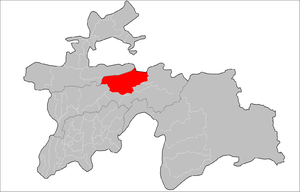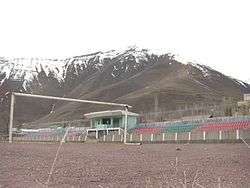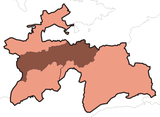Rasht District
Rasht District or Nohiyai Rasht (Tajik: Ноҳияи Рашт/Tajik ناحیهٔ رشت), formerly called Gharm District, is an eastern district in the Region of Republican Subordination in Tajikistan. It lies between Vahdat district on the and Jirgatol district on the east; its southern neighbors are Nurobod, Tavildara, and Tojikobod districts; its northern border runs along the eastern finger of Sughd Province and along the international border with Kyrgyzstan. Its capital is Gharm. The population of Rasht district are known as Gharmis.
Administrative divisions

The district is divided administratively into jamoats. They are as follows (and population).[1]
| Jamoats of Rasht District | |
| Jamoat | Population |
|---|---|
| Askalon | |
| Gharm | 5527 |
| Hijborak | 6871 |
| Hoit | 9613 |
| Jafr | 5038 |
| Kalai Surkh | 9727 |
| Kalanak | 6420 |
| Kaznok | 9589 |
| Navdi | 10474 |
| Navobod | 4497 |
| Obi Mehnat | |
| Rahimzoda | 6651 |
| Tagoba | 6156 |
| Yasman | |
History

During the 1920s Rasht was a hotbed for the Basmachi, the anti-Soviet resistance in Central Asia. In 1929 Basmachi commander Faizal Maksum crossed from Afghanistan into Tajikistan and briefly captured the city Gharm, only to later be expelled by Soviet forces.[2][3] In the 1920s, during the reorganization of borders in Central Asia, a Gharm Oblast was created out of the old Qarategin and Darvaz, districts of Bukhara. The Garm Oblast consisted of much of the Qarategin Valley, as well as the district of Kalai-Khumb. During the 1950s much of the population of Gharm was forcibly relocated by the government to western Tajikistan. This population of people was known as the Gharmis.
In 1955 the Garm oblast was abolished and the land was redistributed to the Gorno-Badakshan Autonomous Oblast and the Regions under Republican Subordination Oblast. The Gharmis continued to have a distinct clan identity in Tajikistan and when the Civil War in Tajikistan broke out in the newly independent country in 1992 many Gharmis sided with the Islamic opposition. During the war many Gharmis were targeted for massacres. The town of Gharm was controlled by the opposition during the later part of the civil war in Tajikistan.
In 1998 four members of the United Nations Mission of Observers in Tajikistan were murdered by armed men allied with the United Tajik Opposition. These victims were Yutaka Akino, a noted Japanese scholar of Central Asian history, Major Ryszard Szewczyk from Poland; Major Adolfo Scharpegge from Uruguay; and Jourajon Mahramov from Tajikistan.[4]
In July 2007 Rasht District suffered a devastating earthquake (5.5 on the Richter scale).[5]
References
- "List of Jamoats". UN Coordination, Tajikistan. Archived from the original on July 16, 2011. Retrieved April 4, 2009.
- Ritter, William S (1990). "Revolt in the Mountains: Fuzail Maksum and the Occupation of Garm, Spring 1929". Journal of Contemporary History. 25: 547. doi:10.1177/002200949002500408.
- Ritter, William S (1985). "The Final Phase in the Liquidation of Anti-Soviet Resistance in Tadzhikistan: Ibrahim Bek and the Basmachi, 1924-31". Soviet Studies. 37 (4). doi:10.1080/09668138508411604.
- "Archived copy". Archived from the original on 2006-06-17. Retrieved 2010-05-01.CS1 maint: archived copy as title (link)
- Tajikistan: Rasht Earthquake and UN Joint appeal
